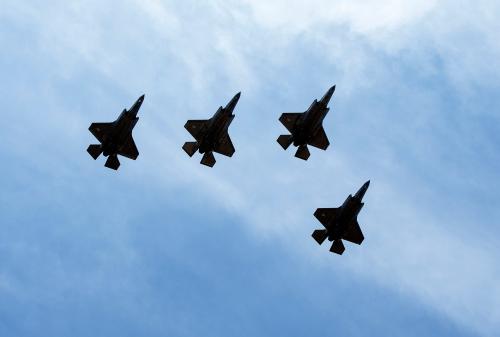Over the last two weeks, there has been much written about whether America’s fledgling Space Force should use naval ranks to organize its structure and hierarchy, or stick with the traditional rank titles of its parent service, the U.S. Air Force. The issue is subject to draft legislation that recently passed the House of Representatives (technically subtitle C of Title IX of the upcoming annual National Defense Authorization Act). This so-called “Starfleet Amendment” would require the Space Force to use naval ranks. There are principled, reasoned arguments on both sides, and even William Shatner, who for over 40 years has played the fictional Star Trek universe’s most famous and accomplished starship captain has weighed in — unsurprisingly in favor of incorporating a more sea-going rank structure.
Those who argue in favor of keeping Air Force ranks — I’ll call them traditionalists for simplicity’s sake — generally believe that military space defense and control operations (and increasingly space dominance) has its roots primarily in the culture of the Air Force. Thus, to help protect the clear overlap between air and space missions, keeping the same rank structure makes the most sense to help facilitate close cooperation between the Air Force and the Space Force. There is also apparently some concern that trending too closely to science fiction tropes could undercut the legitimacy of the Space Force, just as it’s getting off the proverbial ground.
On the other side of the argument, are those — let’s call them optimists — who are more interested in “leaning in” to the distinction between Space Force and Air Force missions and, for that matter, culture. In advocating on behalf of naval ranks, these optimists hope that doing so will help separate the Air Force and Space Force in much the same way that the Marine Corps (which uses a land-based rank structure that ostensibly has the advantage of facilitating operations with its Army counterparts) and Navy, are separate. More substantively, the optimists are also seemingly more likely to take a long view, in that they acknowledge that outer space, as a domain, shares more in common with the maritime than the air, and thus are thinking forward to a future that will no doubt include manned ships to undertake sea-power-like missions, where naval ranks would make more sense than land-based ranks.
In a sense, both the traditionalists and the optimists are treating the rank debate as one of the first salvos in the discussion of what the Space Force will come to be. And if we are interested in being precise, really this discussion equally implicates the Space Command, because presumably Space Force will not be conducting operations, but will instead staff, train, and equip combatant commanders in the same manner as the Army, Navy, Air Force, Marines, and somewhat less cleanly, the Coast Guard. (The Coast Guard does provide for an interesting alternative to the presumptive organizational relationship between the Space Force and Space Command and in fact, the Starfleet Amendment does contemplate operational responsibilities for the Space Force, beyond the traditional post-Goldwater-Nichols “staff, train, and equip” mission of the other services.)
Leaving aside for now the relationship between the Space Force and Space Command, what underlies all of the discussion about which rank structure to use is the concern, on both sides, that this decision will help shape the culture, and in some respects, the likely functional prioritization of the service for the immediate years to come. That is of course the more important question, much more so than how we intend to refer to an E-5 or O-3 in the Space Force.
As the start to a solution, it may make sense to simply separate out functional areas using a broad distinction between “looking down” and “looking out.” The “looking down” mission space could include most of what the Air Force had been doing in space for more than the last 50 years — largely the exploitation of the domain to support terrestrial defense operations, be it advanced warning, missilry, ready access to precision navigation and timing information, communications, reconnaissance, imagery, or data collection/signals intelligence. This would also necessarily include the ability to defend against threats to these capabilities.
Alternatively, “looking out” would capture the near future of space operations, likely starting with the inevitable increase in cislunar traffic between the Earth and the moon, some of which will be manned. As the future space operations — both civilian and military — extend outward, there will of course be a foreseeable need to project military power into the expanse, hortatory language of the Outer Space Treaty notwithstanding.
Further, applying this “looking down” versus “looking out” analytical paradigm may also help answer the question we started with regarding which rank structure to use, to which I’d propose: Why not both? Those Space Force members trained in executing “look down” missions could use a terrestrial rank structure because doing so marries nicely with their Air Force counterparts both in terms of mission execution and cultural legacy. And those who will eventually be trained to conduct “looking out” missions can use naval ranks, in recognition that “look down” functionality of the space domain is but one aspect of the broader potential of outer space. Both would be Space Force members, but their honorifics and titles would change based on their mission responsibilities, which could be visually depicted using easily distinguishable uniform patches or devices in addition to the traditional military collar insignia or striping. Indeed, developing uniforms that employ either collar insignia or sleeve striping/shoulder boards may in fact be an easy way to accomplish this distinction in that the same uniform would simply use differing indicators of rank — collar devices for “look down”-type Space Force members and sleeve striping/shoulder boards for “look out”-type Space Force members.
Optimally, the Space Force would allow for flexible transitions back and forth between “look down” service and “look out” service, depending on service need, qualifications, and available billets, and retiring members eligible for both could choose their terminal title in a manner similar to which selectees into the baseball hall of fame pick what hat they’d like to wear upon induction.
Ultimately, while the discussion over which type of rank structure the Space Force should use is interesting and arguably important to help shape the trajectory of the Space Force’s cultural identity, more pressing issues remain, including how the Space Force plans on collaborating with U.S. allies and other departments and agencies in the domain, the development of the necessary express statutory and legal authority to operate across the full spectrum of foreseeable space defense operations, deeper discussion on the interaction between commercial space and military space operations, realistic budgetary needs that will help insulate the Space Force from the specter of future de-prioritization within the Department of Defense, clarity around what role the Space Force will play in planetary defense, and of course further doctrinal development. Thinking about organizing the Space Force using a “look down” and “look out” analytical paradigm may also help better frame these issues for further analysis as well.
The views expressed are the author’s alone and do not reflect the official policy or position of the United States Coast Guard, U.S. Department of Defense, or the U.S. Government.
The Brookings Institution is committed to quality, independence, and impact.
We are supported by a diverse array of funders. In line with our values and policies, each Brookings publication represents the sole views of its author(s).










Commentary
Is Space Force meant to “look down” or “look out”? Titles will tell
September 16, 2020